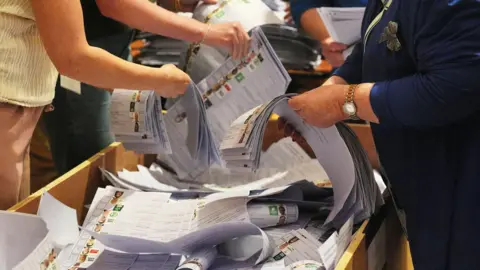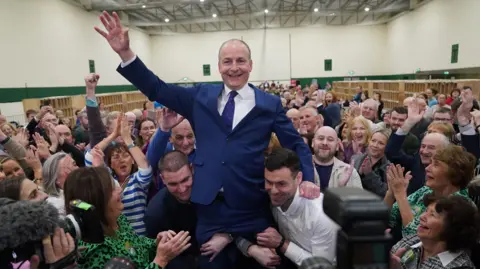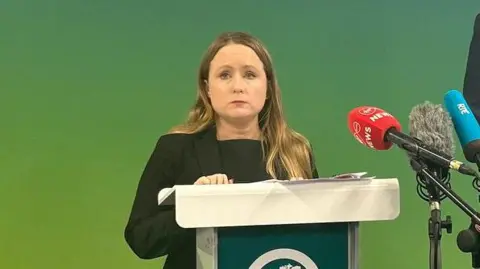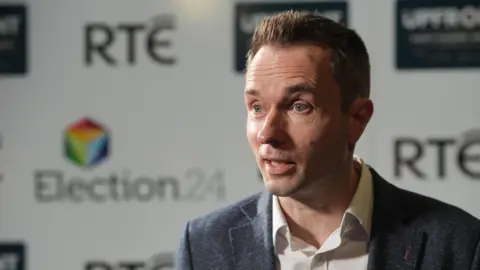 PA Media
PA MediaThe final 12 seats in the Irish general election are expected to be filled later on Monday.
Only a small number of seats separate the three major parties with Fianna Fáil and Fine Gael best placed to form a coalition government.
However, Sinn Féin insists it will still be involved in the coalition talks.
Candidates fought it out for 174 seats in the Dáil (Irish Parliament), 88 of which are needed to secure a majority.
First preference percentage share for the largest three parties was: Fianna Fáil 21.9%, Fine Gael 20.8%, Sinn Féin 19.0%.
Turnout for the election was 59.7%, the lowest in more than a century.
Counting began again after 09:00 local time on Monday, but currently Fianna Fáil is in the lead with 43 seats.
Fine Gael has 36 seats – the same number as the main outgoing opposition party Sinn Féin.
Fianna Fáil’s deputy leader Jack Chambers told RTE’s Morning Ireland on Monday that he did not expect a new government to be formed before Christmas.
However, he said he did not expect talks to take five months like the last time.
Fianna Fáil and Fine Gael served together in the outgoing government, along with the Green Party.
However, the Greens have had a disappointing election having secured just one seat so far.
After a second day of counting votes, Fianna Fáil and Fine Gael are expected to return with a seat total in the mid-80s.
To return to government, they may need the support of one of the smaller parties or a number of the many independent politicians who are expected to be elected as the counting of votes continues on Monday.
The frontrunner to be the next taoiseach (Irish prime minister) is Fianna Fáil leader Michéal Martin.
 PA Media
PA MediaHowever Sinn Féin is adamant that it has a role to play in the negotiations and plans to consult with other left-leaning parties.
But, at best, those parties are likely to finish with a combined total in the 60s and would therefore need the support of independents.
Based on current predictions, the scale of the challenge facing Sinn Féin is enormous.
Nothing at this stage can be ruled out as weeks, if not months, of political talks are now likely.
 PA
PAFormer Finance Minister, Fianna Fáil’s Jack Chambers, who was re-elected in the Dublin West constituency, said his party was “very clear” on its position with Sinn Féin.
“There is no common ground when it comes to substance in policy,” he added.
Speaking to BBC’s Good Morning Ulster, Chambers said: “We’re going to significantly increase our representation here in the capital of Dublin and indeed across the country.
“And we will have a greater level of representation in the next Dáil than we did in the last one, and that’s having served in government when we had serious economic challenges.”
‘Working well together’
Among the new Teachtaí Dála (TDs), as members of the Dáil are known, is Fine Gael’s Emer Currie.
The former Irish senator is a daughter of the late Northern Ireland politician Austin Currie, who co-founded the Social Democratic and Labour Party.
“He would have been absolutely delighted,” Currie told Good Morning Ulster, adding that her election was a “very special” moment for her whole family.
With her party in line to return to government, Currie said the result of the election seemed to indicate that the public was content with the status quo.
“It’s a statement that they felt that Fine Gael and Fianna Fáil were working well together,” she said.
Fianna Fáil senator Malcolm Byrne told the same programme: “For most people that we were talking to on the doorsteps, people felt that the government was doing a good job but there was a lot more to do.”
He said the big issues that had been raised with canvassers during the election campaign were access to housing and healthcare and those would have to be addressed by any incoming coalition government.
 PA
PASinn Féin’s Mairéad Farrell, who topped the poll in Galway West, said Sinn Féin were going to speak “to other progressive parties” to consider “how we can move forward”.
“We’ve always been very clear that we want to be in government, we believe strongly that there needs to be a mandate for change and that all parties should listen to the electorate,” she added.
 PA
PAMeanwhile, Cian O’Callaghan, deputy leader of Social Democrats, said there was a “possibility of a coalition with left parties in it” but due to the results so far, a left only government would not be possible.
Callaghan has been re-elected in Dublin Bay North.
Responding to claims that the left failed to coalesce their argument before the election, O’Callaghan said: “I think every party needs to stand on their own two feet and make the case to the electorate as to why people should vote for them.
“The reason we have different parties is because there is differences and it gives people a different choice as well in the election.”

